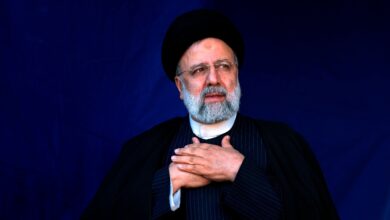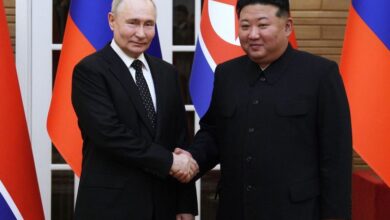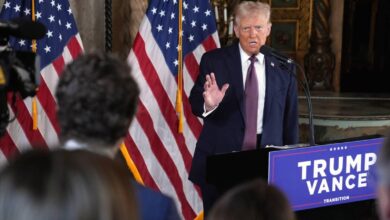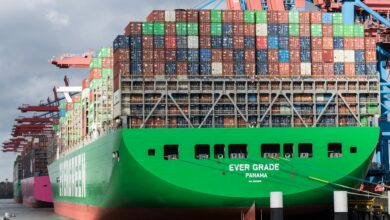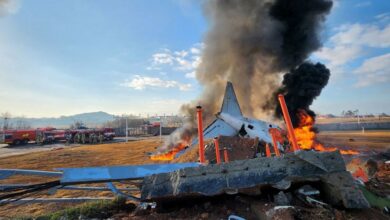G7 Leaders Urge Trump to Ease Tariff Threats as Global Trade Talks Tangle with Iran-Israel Crisis
World leaders at the G7 summit in Canada are urging U.S. President Donald Trump to ease trade tariffs, while divisions grow over how to respond to rising tensions between Iran and Israel.

KANANASKIS, Alberta (WE) — Leaders of the Group of Seven (G7) met this week in Canada to confront rising tensions over trade and Middle East conflict. But instead of unity, the summit highlighted deep divisions. The main focus remained on persuading U.S. President Donald Trump to back off his aggressive tariff policies.
The G7 includes Canada, France, Germany, Italy, Japan, the United Kingdom, and the United States. These nations met in Québec for a three-day summit hosted by Canadian Prime Minister Mark Carney.
Trump said trade was his “primary focus” as he arrived. His administration has slapped a 10 percent baseline tariff on many imports, hitting both allies and competitors. Canada, the host, has suffered additional levies on aluminum, steel, dairy, and lumber.
Mexican President Claudia Sheinbaum also attended the summit as a guest. She plans to renegotiate the North American Free Trade Agreement (NAFTA), now rebranded as the United States-Mexico-Canada Agreement (USMCA). Her goal is to protect Mexican exports from new U.S. tariffs.
Trump brought U.S. Trade Representative Jamieson Greer to the talks. He leads discussions with several countries hoping to finalize agreements before July. Trump has warned he may impose more “reciprocal” tariffs if partners don’t meet his demands.
Last week, Treasury Secretary Scott Bessent said Washington might delay the July deadline for nations showing “good faith” in talks. That statement gave some hope to allies under pressure.
German Chancellor Friedrich Merz said he plans to work with French President Emmanuel Macron and Italian Prime Minister Giorgia Meloni to shift Trump’s stance. “We won’t find a solution here,” Merz told reporters. “But we might take small steps toward it.”
European Commission President Ursula von der Leyen echoed that view. She arrived with Trade Commissioner Maroš Šefčovič. “Let’s keep trade fair, predictable, and open,” she said in a veiled criticism of U.S. tariffs.
UK Prime Minister Keir Starmer shared progress on Britain’s own deal. The UK signed a preliminary trade pact with the U.S. in May. It limits future tariffs, though the 10 percent rate still applies for now. Starmer said the final version is close.
Despite these talks, global concern continues to grow. Tariffs have sparked warnings from economists and trade groups. Many say the strategy could damage global markets and shake confidence in multilateral institutions like the World Trade Organization (WTO).
But trade isn’t the only source of friction. Leaders also debated a joint statement on the worsening conflict between Israel and Iran.
On Monday, an Israeli air strike hit an Iranian state television station during a live broadcast. The attack increased tensions. G7 leaders now face pressure to call for de-escalation.
However, they appear divided on how to respond.
Al Jazeera’s James Bays reported from the summit that Trump rejected language urging restraint. “President Trump seems unwilling to endorse any statement about de-escalation,” Bays said. “European leaders have backed the idea from the start, but there’s no agreement.”
Japan also made its position clear. Its government sharply condemned Israel’s actions, setting it apart from both Trump and some European leaders.
This disagreement complicates efforts to issue a unified statement. Officials hoped the G7 would present a common front on security and economic stability. Now, even that seems uncertain.
Still, the summit offered moments of direct diplomacy. Trump met privately with Macron and Starmer during a Sunday evening dinner at a lakeside retreat. According to several officials, the conversations focused on tariffs, NAFTA, and the Middle East.
The atmosphere remained civil but tense. “The G7 was never about total agreement,” said Ian Bremmer, president of the Eurasia Group. “It’s about managing friction without breaking global cooperation.”
For some countries, even partial progress would count as a win. Canadian officials said they are exploring “creative solutions” to exempt their key exports. They aim to offer Trump concessions without sacrificing national pride.
Read More:
- Seven Killed in Helicopter Crash in India’s Uttarakhand State
- IRGC Confirms Death of Seven Top Aerospace Force Commanders in Israeli Strike; Khamenei Appoints Majid Mousavi as New Chief
- Iran Launches Missile Barrage on Israel Following Israeli Strikes on Iranian Infrastructure
European negotiators feel the same urgency. Their economies depend on stable access to the U.S. market. However, they refuse to accept what they see as bullying.
Trump’s team has defended its approach as long overdue. One senior U.S. official said, “We’re correcting years of one-sided trade deals. We’re not punishing our allies. We just want balance.”
Yet that logic has failed to convince many partners. Several countries have already filed complaints with the WTO. Others are drafting retaliatory measures in case talks collapse.
Meanwhile, the Iran-Israel conflict remains unpredictable. Iran has promised to retaliate. Tensions are rising across the region, with groups like Hezbollah vowing support for Iran.
The United Nations has called for restraint. But hopes for a G7-backed resolution have faded. Without consensus, any joint statement is likely to be vague or delayed.
Protesters outside the summit have voiced frustration with global leaders. Activists criticized Trump’s trade tactics, the G7’s failure to act on climate, and silence on war. The protests have remained peaceful. Police established a wide security perimeter around the summit site.
As the final day begins, diplomats are racing to draft a communiqué. Officials say it will emphasize dialogue, but may lack firm commitments. One EU advisor said, “We’ll agree on the value of trade. But specific solutions are still far away.”
For the G7, the stakes are higher than ever. Trade imbalances, political tension, and the threat of war all hang over the summit. Leaders will return home to domestic pressure, uncertain markets, and allies watching their next moves.
Whether this meeting lays groundwork for progress—or exposes deeper cracks—remains to be seen. But the push to restrain Trump’s tariff drive and manage global conflict has dominated every discussion.
The G7’s ability to preserve international stability may depend on what happens in the weeks ahead. For now, the summit has shown how fragile global unity really is.

